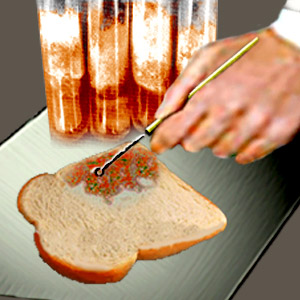Concept 16 One gene makes one protein.

In 1902, Archibald Garrod described the inherited disorder alkaptonuria as an "inborn error of metabolism." He proposed that a gene mutation causes a specific defect in the biochemical pathway for eliminating liquid wastes. The phenotype of the disease — dark urine — is a reflection of this error.
This hypothesis was rigorously proven in 1941 by George Beadle and Edward Tatum, using the simple bread mold Neurospora. First, they found that molds exposed to radiation lose the ability to produce essential nutrients, and this slowed, even stopped the growth of the mold. Then, they found that growth can be restored by providing the mutated mold with a specific supplement. They reasoned that each mutation must inactivate the enzyme (protein) needed to synthesize the nutrient. Thus, one gene carries the directions for making one protein.
 DNA and proteins are key molecules of the cell nucleus.
DNA and proteins are key molecules of the cell nucleus. One gene makes one protein.
One gene makes one protein. A gene is made of DNA.
A gene is made of DNA. Bacteria and viruses have DNA too.
Bacteria and viruses have DNA too. The DNA molecule is shaped like a twisted ladder.
The DNA molecule is shaped like a twisted ladder. A half DNA ladder is a template for copying the whole.
A half DNA ladder is a template for copying the whole. RNA is an intermediary between DNA and protein.
RNA is an intermediary between DNA and protein. DNA words are three letters long.
DNA words are three letters long. A gene is a discrete sequence of DNA nucleotides.
A gene is a discrete sequence of DNA nucleotides. The RNA message is sometimes edited.
The RNA message is sometimes edited. Some viruses store genetic information in RNA.
Some viruses store genetic information in RNA. RNA was the first genetic molecule.
RNA was the first genetic molecule. Mutations are changes in genetic information.
Mutations are changes in genetic information. Some types of mutations are automatically repaired.
Some types of mutations are automatically repaired.